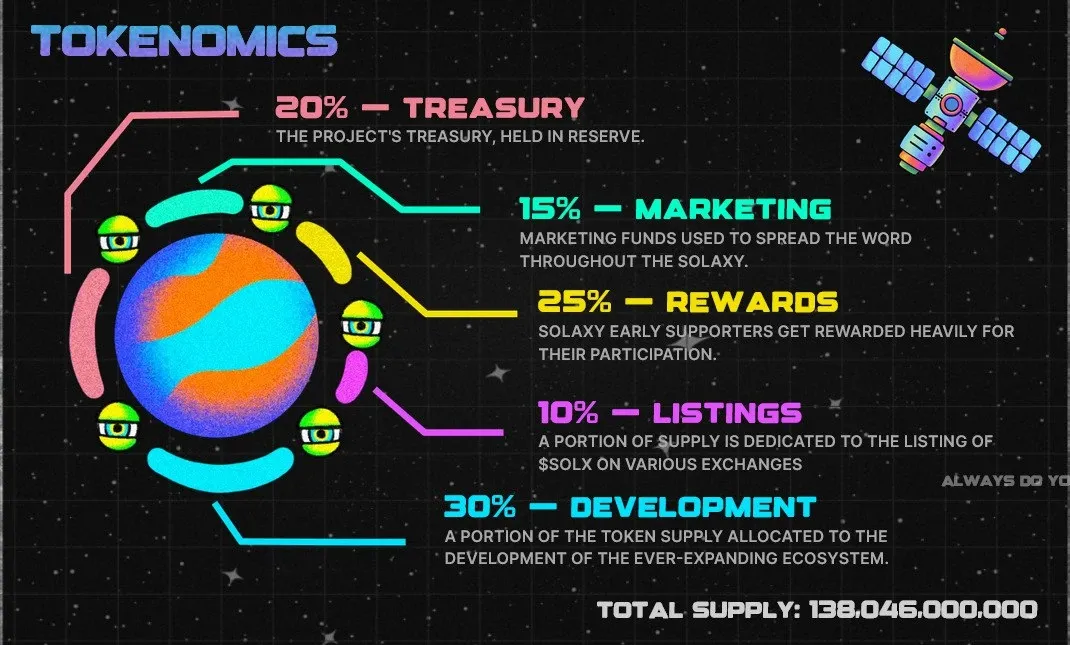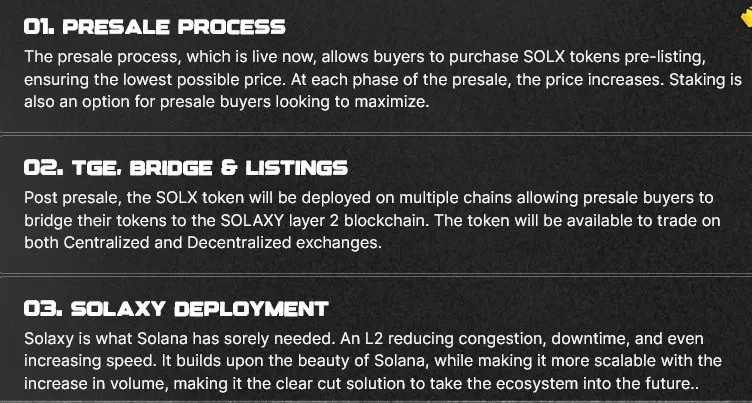Solaxy and the SOLX Token Explained: An L2 on Solana
The Solana Scaling Challenge
Solana stormed the blockchain world with its promise of lightning-fast transactions and minimal fees, often touted as an Ethereum rival. Yet, its meteoric rise—driven by DeFi, NFTs, and meme coin mania—has pushed the network to its limits. During peak demand, like the TRUMP token surge in early 2025, Solana falters, plagued by congestion and delays.
The numbers reveal the strain:
- Practical Throughput: 2,000–4,000 TPS on average, based on real-world validator performance.
- Theoretical Peak: Up to 65,000 TPS in lab conditions, a benchmark far from operational reality.
- Peak Failures: Non-voting transaction failure rates can spike—sometimes nearing 50% during heavy loads—due to spam and validator bottlenecks.
These gaps between promise and performance underscore the need for a scaling fix. Solaxy L2 emerges as a Layer-2 contender for Solana, aiming to bridge that divide, though it joins a growing ecosystem of L2 solutions like Solayer, Soon, and Sonic, each addressing Solana's scalability challenges with distinct approaches.
Interestingly, Solaxy embraces the memecoin ethos that Solana has become known for, combining serious technical ambitions with the playful, community-driven spirit that has fueled many successful crypto projects.
What is Solaxy L2?
Solaxy L2 is engineered to relieve Solana's congestion woes. It's an off-chain scaling layer that processes transactions separately before settling them on the mainnet—a proven strategy inspired by Ethereum's rollup success.
Here's how it works:
Off-Chain Express Lane
Think of Solana's mainnet as a jammed freeway. Solaxy creates a side route, handling transactions off-chain at scale, then batching them for mainnet confirmation.
Rollup Technology
Using the Solana Virtual Machine (SVM) inside a zero-knowledge virtual machine (zkVM), Solaxy bundles multiple transactions into one compact entry. Devnet tests show this cuts validator load while preserving security.
Cross-Chain Vision
Via Hyperlane, Solaxy is building a Solana-Ethereum bridge, with a UI in progress. This could link Solana's speed to Ethereum's liquidity, though broader chain support (e.g., Base) remains unconfirmed.
The $SOLX Token: Explained
The $SOLX token is going to power Solaxy's ambitions. By March 13, 2025, its ongoing presale has raised $26 million, with $SOLX at $0.00166 per token in the current round. Its economic model, detailed in the project's tokenomics, is built for growth:
- Total Supply: 138,046,000,000 $SOLX.
- Allocation:
- 30% Development (41,413,800,000 $SOLX) funds the ever-expanding ecosystem.
- 25% Rewards (34,511,500,000 $SOLX) heavily rewards early supporters, including presale buyers.
- 20% Treasury (27,609,200,000 $SOLX) is held in reserve.
- 15% Marketing (20,706,900,000 $SOLX) spreads the word.
- 10% Listings (13,804,600,000 $SOLX) supports exchange liquidity.

Presale Staking Program
It's important to understand how staking works during Solaxy's presale phase. Investors aren't staking actual tokens, as the TGE (token generation event) hasn't occurred yet. Instead, they're committing their presale funds to a staking option.
The allocation is likely drawn from the Rewards pool, with over 7 billion $SOLX already pledged in staking. Presale buyers are early supporters and currently earn a 159% APY. Staking rewards accrue as future $SOLX, claimable post-TGE over a three-year vesting period.
According to Solaxy's staking page: "The distribution of SOLX token rewards will occur at a rate of 4377.4 SOLX tokens per ETH block. These rewards will be disbursed over 3 years and will be claimable once claim goes live."
This structure balances early incentives with long-term growth and has drawn significant presale interest.
Market Context and Potential Impact
Solana's ecosystem is ripe for Solaxy's intervention. DeFi TVL hit $12 billion by February 2025, and a 27% $SOL price jump in early March—sparked by Trump's crypto reserve talk—signals robust growth. Yet, congestion threatens this momentum.
Solaxy could reshape the landscape in several ways. By reducing transaction failures during peak activity, it could support the reliability needed for sensitive DeFi operations that currently face execution risks on Solana's congested mainnet. The improved infrastructure would strengthen the broader appeal of the Solana ecosystem.
Development and Future Outlook
Solaxy is pre-mainnet, with its devnet active—rollups and bridges are in testing, but no live product exists yet. The roadmap includes:
- Completing the presale (now at $26 million).
- A Token Generation Event and exchange listings.
- Full L2 mainnet deployment.
- dApp onboarding and scaling refinements.
A Q2–Q3 2025 launch is speculated, not confirmed, with post-TGE pricing to be market-driven. Drawing from Ethereum's Layer-2 wins, Solaxy aims to cut congestion and costs—if it delivers, it could lead among Solana's L2 solutions.

Conclusion: A Pivotal Bet for Solana
Solaxy L2 isn't just tech—it's a bid to enhance Solana's broader ecosystem. By tackling congestion head-on with its rollup-based approach, it could unlock scalability without sacrificing Solana's edge, though it competes with other L2 projects like Solayer, Soon, and Sonic. For developers, investors, and users, it's a high-stakes play with execution risks ahead.
While Solaxy has serious technical ambitions, it's worth noting that the project also embraces its identity as a meme coin—a fact acknowledged in its own disclaimer: "This is a meme coin." This dual nature represents the evolving cryptocurrency landscape, where technical innovation and community-driven meme culture increasingly coexist.
免责声明:投资有风险,本文并非投资建议,以上内容不应被视为任何金融产品的购买或出售要约、建议或邀请,作者或其他用户的任何相关讨论、评论或帖子也不应被视为此类内容。本文仅供一般参考,不考虑您的个人投资目标、财务状况或需求。TTM对信息的准确性和完整性不承担任何责任或保证,投资者应自行研究并在投资前寻求专业建议。
热议股票
- 1
- 2
- 3
- 4
- 5
- 6
- 7
- 8
- 9
- 10